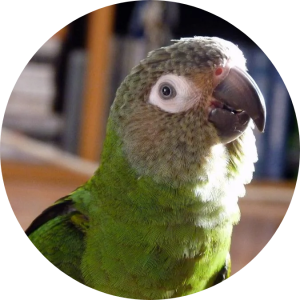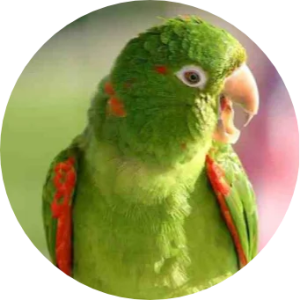Conure
Table of Contents


Description:
Conures are either large parakeets or small parrots found in the Western Hemisphere. They are analogous in size and way of life to Afro-Eurasia’s rose-ringed parakeets or the Australian parakeets. All living conure species live in Central and South America. The extinct Conuropsis carolinensis, or Carolina parakeet was an exception. Conures are often called the clowns of the parrot world due to their constant attention seeking behavior including hanging upside-down and swaying back and forth or “dancing.”
Despite being large for parakeets, conures are lightly built with long tails and small (but strong) beaks. Conure beaks always have a small cere and are usually horn-colored (gray) or black. Most conure species live in flocks of 20 or more birds. Conures often eat grain, and so are treated as agricultural pests in some places.
There’s a reason why conures are popular pet companions; these spunky and often comical parrots come in a range of eye-catching colors and have equally colorful personalities. Conures are one of the more varied groups of parrots. These small to medium parrots with long tail feathers range in size to just under 10 inches to just over 20 inches, depending on the conure species.
Diet:
The condition of the individual will dictate the dietary needs. For example, the following activities will cause the dietary needs to vary: activity level, physiological condition, growth, breeding, egg-laying, rearing youth, and molting. Other than pellet mixes and seed mixes there are fresh foods that are acceptable for Conures to consume.
| Category | Foods |
|---|---|
| Greens | chard, mustard, sorrel, cilantro, parsley, kale, collards, carrot tops, rapini, endive, arugula |
| Vegetables | pepper, squash, cauliflower, cabbage, carrot, beet, yam, pumpkin, snow pea, broccoli, kohlrabi, potato, cooked beans (e.g., garbanzo, kidney, peas, limas, black-eyed peas) |
| Fruits | apple, grape, berries, banana, pear, plum, mango, cantaloupe, melons, papaya, fig |
| Pasta | various shapes, whole grain (wheat, spelt, etc.) |
| Grains | brown rice, barley, millet, amaranth, quinoa, farina, oats, corn |
| Nuts | Brazil nut, almond, walnut, pine nut, filbert, cashew, nut butters |
| Protein | tofu, chicken, salmon |
| Dairy | yogurt, cheese (small amounts) |
Facts about Conures:
There are many types of conures, and they vary widely in size, coloration, and lifespan. The smallest conure is the Painted Conure Pyrrhura picta which ranges from 8 1/2 to 9 1/2 inches (21.5 – 24 cm) in length. The Patagonian Conures Cyanoliseus patagonus sp. are the largest conures, reaching up to 17 3/4 to 19 inches (45 – 48 cm).
The average life span of conures is really unknown on most species. It is known that conures live longer in captivity than they do in the wild, and larger birds live longer than smaller birds. In general, small conures can live up to about 15 years, while some of the larger conures have been known to live for 35 years or more.
This is a large and diverse group of parrots. Although each species has it own unique characteristics, there are some common features all conures share.
Characteristics found in all types of conures:
- In general, conures have slender bodies and long, tapered tails. Yet some varieties have short tails that become narrow at the tip, while others have long, slender tails.
- The colors of conures can be very rich with the plumage of each species having its own color palate. Colors can range from rich greens to brilliant yellows, reds and oranges, and into the whites and browns.
- Conures have broad heavy beaks of black or light horn color. Use of their beak is multi-faceted. They have a hooked upper bill that they use to climb, hold things, or to dig. They also use their beak to chew, break seeds, and peel fruit.
- Conures have a fairly broad cere at the base of the beak.
- Almost all Conures have a clearly defined eye ring, with the females generally having a somewhat narrower ring than the males.
- Each type of conure has its own set of calls, but they are generally harsh and can be loud. These are all fairly intelligent parrots and many can learn to “talk”. Many are quite adept at mimicking sounds they hear and some will repeat words, phrases and even whistle.
- All types of conures are naturally active and will stay very busy. They will always be climbing and flying from perch to perch. They will intently chew on toys and anything else that they can reach.
Housing & Cage:
conures are active and curious birds, and should be provided with a cage that is a minimum size of 24″ x 24″ x 30″. The larger the cage, the more comfortable it will be for the bird. A good cage should have horizontal bars on at least two sides, as conures are very acrobatic, and love to climb. Horizontal bars help to make climbing easier. Bar spacing should be no more than 1 inch apart to prevent injury.
Sun conures can be kept at room temperature. Be sure to place your bird and its cage off of the floor and away from drafty areas or hot places like open windows, air vents and doorways.
Your conure’s cage should have at least two or three perches of various sizes, shapes and textures so that its feet stay healthy and strong. Make sure the perches are thick enough for the bird to stand comfortably on them without losing its balance. You want to offer at least two perches but you also do not want to overcrowd the cage, larger cages may have room for more than two perches.
If your bird is housed in a quiet room, you may want to get a cover for your bird’s cage to help it to sleep at night. If your bird lives in a more active room, it may be kept awake by even low volume sounds, and will not get the proper rest that it needs to stay healthy. In this case, you may want to get a smaller cage for your bird to sleep in and place it in a quieter room. Using a sleep cage will give your bird a safe, quiet place to get a good night’s sleep.
Breeding/Reproduction:
In their natural environment, the Conure nests in a tree hollow. The female lays quite a large clutch of four to seven eggs which are incubated for 21 to 27 days. The young leave the nest at six to eight weeks.
Grooming and Hygiene:
Birds like to bathe, but different individuals prefer to bathe in different ways. Some like to bathe in a shallow dish, some like to be sprayed with a fine mist and still others like to get in the shower with their owner. Since many parrots come from regions of the world that get a great deal of rainfall, it’s important to give birds a chance to get wet every day as long as they are in good health.
Clipping your bird’s flight feathers is not necessary but usually helps in taming your bird. It also helps to prevent escape and injury. Birds like parrots cannot survive in the climate of most US states and even in warmer areas would not survive without a flock (a flock protects them from predators as there is safety in numbers). For this reason, please consider carefully before allowing a parrot to remain flighted. Consult your avian vet to have the wings clipped by a qualified professional. Nails should also be trimmed by a qualified person if they get too long, unhealthy, and hinder the bird’s movements.
TYPES OF CONURES















